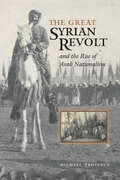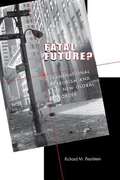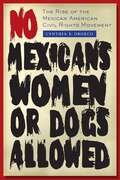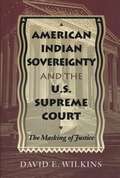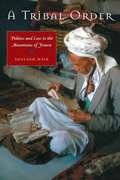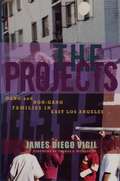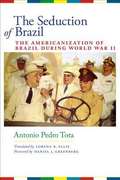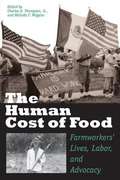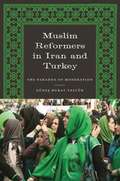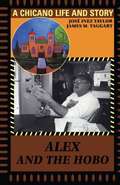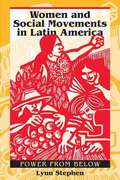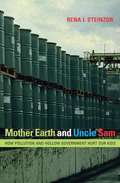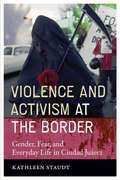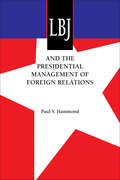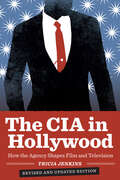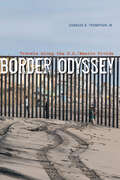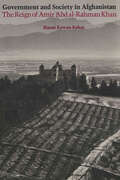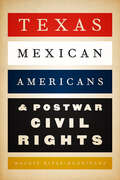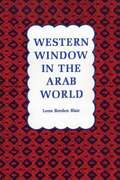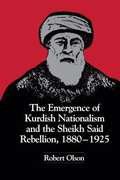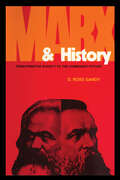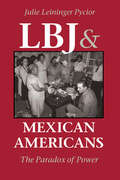- Table View
- List View
The Great Syrian Revolt and the Rise of Arab Nationalism (CMES Modern Middle East Series)
by Michael ProvenceThe Great Syrian Revolt of 1925 was the largest and longest-lasting anti-colonial insurgency in the inter-war Arab East. Mobilizing peasants, workers, and army veterans, rather than urban elites and nationalist intellectuals, it was the first mass movement against colonial rule in the Middle East. The revolt failed to liberate Syria from French occupation, but it provided a model of popular nationalism and resistance that remains potent in the Middle East today. Each subsequent Arab uprising against foreign rule has repeated the language and tactics of the Great Syrian Revolt.<P><P>In this work, Michael Provence uses newly released secret colonial intelligence sources, neglected memoirs, and popular memory to tell the story of the revolt from the perspective of its participants. He shows how Ottoman-subsidized military education created a generation of leaders of modest background who came to rebel against both the French Mandate rulers of Syria and the Syrian intellectuals and landowners who helped the colonial regime to function. This new popular nationalism was unprecedented in the Arab world. Provence shows compellingly that the Great Syrian Revolt was a formative event in shaping the modern Middle East.
Fatal Future?: Transnational Terrorism and the New Global Disorder
by Richard M. Pearlstein"As the media has zeroed in on the individual victims, heroes, and perpetrators of 9/11, followed the fighting in Afghanistan, and chronicled the 'war against terrorism' at home, there has been a crying need for a short, sober book like this one . . . to] provide a broader context. It shows that 9/11 was not unexpected, if unpredicted. " -- J. Garry Clifford, Professor of Political Science, University of Connecticut The nature and goals of terrorist organizations have changed profoundly since the Cold War standoff among the U. S. , Soviet, and Chinese superpowers gave way to the current "polyplex" global system, in which the old rules of international engagement have been shattered by a new struggle for power among established states, non-state actors, and emerging nations. In this confusing state of global disorder, terrorist organizations that are privately funded and highly flexible have become capable of carrying out incredibly destructive attacks anywhere in the world in support of a wide array of political, religious, and ethnic causes. This groundbreaking book examines the evolution of terrorism in the context of the new global disorder. Richard M. Pearlstein categorizes three generations of terrorist organizations and shows how each arose in response to the global conditions of its time. Focusing extensively on today's transnational (i. e. , privately funded and internationally operating) terrorist organizations, he devotes thorough attention to the two most virulent types: ethnoterrorism and radical Islamic terrorism. He also discusses the terrorist race for weapons of mass destruction and the types of attacks, including cyberterrorism, that are likely to occur incoming years. Pearlstein concludes with a thought-provoking assessment of the many efforts to combat transnational terrorism in the post-September 11 period.
No Mexicans, Women, or Dogs Allowed: The Rise of the Mexican American Civil Rights Movement
by Cynthia E. Orozco“A refreshing and pathbreaking [study] of the roots of Mexican American social movement organizing in Texas with new insights on the struggles of women” (Devon Peña, Professor of American Ethnic Studies, University of Washington).Historian Cynthia E. Orozco presents a comprehensive study of the League of United Lantin-American Citizens, with an in-depth analysis of its origins. Founded by Mexican American men in 1929, LULAC is often judged harshly according to Chicano nationalist standards of the late 1960s and 1970s. Drawing on extensive archival research, No Mexicans, Women, or Dogs Allowed presents LULAC in light of its early twentieth-century context.Orozco argues that perceptions of LULAC as an assimilationist, anti-Mexican, anti-working class organization belie the group's early activism. Supplemented by oral history, this sweeping study probes LULAC's predecessors, such as the Order Sons of America, blending historiography and cultural studies. Against a backdrop of the Mexican Revolution, World War I, gender discrimination, and racial segregation, No Mexicans, Women, or Dogs Allowed recasts LULAC at the forefront of civil rights movements in America.
American Indian Sovereignty and the U.S. Supreme Court: The Masking of Justice
by David E. Wilkins"Like the miner's canary, the Indian marks the shift from fresh air to poison gas in our political atmosphere; and our treatment of Indians, even more than our treatment of other minorities, reflects the rise and fall in our democratic faith," wrote Felix S. Cohen, an early expert in Indian legal affairs. In this book, David Wilkins charts the "fall in our democratic faith" through fifteen landmark cases in which the Supreme Court significantly curtailed Indian rights. He offers compelling evidence that Supreme Court justices selectively used precedents and facts, both historical and contemporary, to arrive at decisions that have undermined tribal sovereignty, legitimated massive tribal land losses, sanctioned the diminishment of Indian religious rights, and curtailed other rights as well. These case studies-and their implications for all minority groups-make important and troubling reading at a time when the Supreme Court is at the vortex of political and moral developments that are redefining the nature of American government, transforming the relationship between the legal and political branches, and altering the very meaning of federalism.
A Tribal Order: Politics and Law in the Mountains of Yemen
by Shelagh WeirA Tribal Order describes the politico-legal system of Jabal Razih, a remote massif in northern Yemen inhabited by farmers and traders.<P><P> Contrary to the popular image of Middle Eastern tribes as warlike, lawless, and invariably opposed to states, the tribes of Razih have stable structures of governance and elaborate laws and procedures for maintaining order and resolving conflicts with a minimum of physical violence. Razihi leaders also historically cooperated with states, provided the latter respected their customs, ideals, and interests. Weir considers this system in the context of the rugged environment and productive agricultural economy of Razih, and of centuries of continuous rule by Zaydi Muslim regimes and (latterly) the republican governments of Yemen.
The Projects
by James Diego VigilThe Pico Gardens housing development in East Los Angeles has a high percentage of resident families with a history of persistent poverty, gang involvement, and crime. In some families, members of three generations have belonged to gangs. Many other Pico Gardens families, however, have managed to avoid the cycle of gang involvement. In this work, Vigil adds to the tradition of poverty research and elaborates on the association of family dynamics and gang membership. The main objective of his research was to discover what factors make some families more vulnerable to gang membership, and why gang resistance was evidenced in similarly situated non-gang-involved families. Providing rich, in-depth interviews and observations, Vigil examines the wide variations in income and social capital that exist among the ostensibly poor, mostly Mexican American residents. Vigil documents how families connect and interact with social agencies in greater East Los Angeles to help chart the routines and rhythms of the lives of public housing residents. He presents family life histories to augment and provide texture to the quantitative information. By studying life in Pico Gardens, Vigil feels we can better understand how human agency interacts with structural factors to produce the reality that families living in all public housing developments must contend with daily.
The Seduction of Brazil: The Americanization of Brazil During World War II
by Antonio Pedro TotaFollowing completion of the U. S. air base in Natal, Brazil, in 1942, U. S. airmen departing for North Africa during World War II communicated with Brazilian mechanics with a thumbs-up before starting their engines. This sign soon replaced the Brazilian tradition of touching the earlobe to indicate agreement, friendship, and all that was positive and good - yet another indication of the Americanization of Brazil under way during this period. In this translation of O Imperialismo Sedutor, Antonio Pedro Tota considers both the Good Neighbor Policy and broader cultural influences to argue against simplistic theories of U. S. cultural imperialism and exploitation. He shows that Brazilians actively interpreted, negotiated, and re-configured U. S. culture in a process of cultural recombination. The market, he argues, was far more important in determining the nature of this cultural exchange than state-directed propaganda efforts because Brazil already was primed to adopt and disseminate American culture within the framework of its own rapidly expanding market for mass culture. By examining the motives and strategies behind rising U. S. influence and its relationship to a simultaneous process of cultural and political centralization in Brazil, Tota shows that these processes were not contradictory, but rather mutually reinforcing. The Seduction of Brazil brings greater sophistication to both Brazilian and American understanding of the forces at play during this period, and should appeal to historians as well as students of Latin America, culture, and communications.
The Human Cost of Food: Farmworkers' Lives, Labor, and Advocacy
by Charles D. Thompson Melinda F. WigginsFinding fresh fruits and vegetables is as easy as going to the grocery store for most Americans--which makes it all too easy to forget that our food is cultivated, harvested, and packaged by farmworkers who labor for less pay, fewer benefits, and under more dangerous conditions than workers in almost any other sector of the U.S. economy. <P><P>Seeking to end the public's ignorance and improve workers' living and working conditions, this book addresses the major factors that affect farmworkers' lives while offering practical strategies for action on farmworker issues. The contributors to this book are all farmworker advocates--student and community activists and farmworkers themselves. Focusing on workers in the Southeast United States, a previously understudied region, they cover a range of issues, from labor organizing, to the rise of agribusiness, to current health, educational, and legal challenges faced by farmworkers. The authors blend coverage of each issue with practical suggestions for working with farmworkers and other advocates to achieve justice in our food system both regionally and nationally.
Muslim Reformers in Iran and Turkey
by Güne Murat TezcürModeration theory describes the process through which radical political actors develop commitments to electoral competition, political pluralism, human rights, and rule of law and come to prefer negotiation, reconciliation, and electoral politics over provocation, confrontation, and contentious action.<P><P> Revisiting this theory through an examination of two of the most prominent moderate Islamic political forces in recent history, Muslim Reformers in Iran and Turkey analyzes the gains made and methods implemented by the Reform Front in the Islamic Republic of Iran and the Justice and Development Party in Turkey. Both of these groups represent Muslim reformers who came into continual conflict with unelected adversaries who attempted to block their reformist agendas. Based on extensive field research in both locales, Muslim Reformers in Iran and Turkey argues that behavioral moderation as practiced by these groups may actually inhibit democratic progress. Political scientist Günes Murat Tezcür observes that the ability to implement conciliatory tactics, organize electoral parties, and make political compromises impeded democracy when pursued by the Reform Front and the Justice and Development Party. Challenging conventional wisdom, Tezcür's findings have broad implications for the dynamics of democratic progress.
Alex and the Hobo: A Chicano Life and Story
by Taylor James M. Taggart José InezWhen a ten-year-old boy befriends a mysterious hobo in his southern Colorado hometown in the early 1940s, he learns about evil in his community and takes his first steps toward manhood by attempting to protect his new friend from corrupt officials. Though a fictional story, Alex and the Hobo is written out of the life experiences of its author, José Inez (Joe) Taylor, and it realistically portrays a boy's coming-of-age as a Spanish-speaking man who must carve out an honorable place for himself in a class-stratified and Anglo-dominated society. In this innovative ethnography, anthropologist James Taggart collaborates with Joe Taylor to explore how Alex and the Hobo sprang from Taylor's life experiences and how it presents an insider's view of Mexicano culture and its constructions of manhood. They frame the story (included in its entirety) with chapters that discuss how it encapsulates notions that Taylor learned from the Chicano movement, the farmworkers' union, his community, his father, his mother, and his religion. Taggart gives the ethnography a solid theoretical underpinning by discussing how the story and Taylor's account of how he created it represent an act of resistance to the class system that Taylor perceives as destroying his native culture.
Ross Sterling, Texan: A Memoir by the Founder of Humble Oil and Refining Company
by Ed Kilman Ross S. SterlingBorn on a farm near Anahuac, Texas, in 1875 and possessed of only a fourth-grade education, Ross Sterling was one of the most successful Texans of his generation. Driven by a relentless work ethic, he become a wealthy oilman, banker, newspaper publisher, and, from 1931 to 1933, one-term governor of Texas. Sterling was the principal founder of the Humble Oil and Refining Company, which eventually became the largest division of the ExxonMobil Corporation, as well as the owner of the Houston Post. <P><P> Eager to "preserve a narrative record of his life and deeds," Ross Sterling hired Ed Kilman, an old friend and editorial page editor of the Houston Post, to write his biography. Though the book was nearly finished before Sterling's death in 1949, it never found a publisher due to Kilman's florid writing style and overly hagiographic portrayal of Sterling.
Women and Social Movements in Latin America
by Lynn StephenWomen's grassroots activism in Latin America combines a commitment to basic survival for women and their children with a challenge to women's subordination to men. This comparative study explores six cases of women's grassroots activism in Mexico, El Salvador, Brazil and Chile.
Mother Earth and Uncle Sam
by Rena I. SteinzorIn this compelling study, Rena Steinzor highlights the ways in which the government, over the past twenty years, has failed to protect children from harm caused by toxic chemicals. She believes these failures--under-funding, excessive and misguided use of cost/benefit analysis, distortion of science, and devolution of regulatory authority--have produced a situation in which harm that could be reduced or eliminated instead persists. Steinzor states that, as a society, we are neglecting our children's health to an extent that we would find unthinkable as individual parents, primarily due to the erosion of the government's role in protecting public health and the environment. At this pace, she asserts, our children will inherit a planet under grave threat. We can arrest these developments if a critical mass of Americans become convinced that these problems are urgent and the solutions are near at hand. By focusing on three specific case studies--mercury contamination through the human food chain, perchlorate (rocket fuel) in drinking water, and the effects of ozone (smog) on children playing outdoors--Steinzor creates an analysis grounded in law, economics, and science to prove her assertions about the existing dysfunctional system. Steinzor then recommends a concise and realistic series of reforms that could reverse these detrimental trends and serve as a blueprint for restoring effective governmental intervention. She argues that these recommendations offer enough material to guide government officials and advocacy groups toward prompt implementation, for the sake of America's--and the world's--future generations.
Violence and Activism at the Border
by Kathleen StaudtBetween 1993 and 2003, more than 370 girls and women were murdered and their often-mutilated bodies dumped outside Ciudad Juárez in Chihuahua, Mexico. The murders have continued at a rate of approximately thirty per year, yet law enforcement officials have made no breakthroughs in finding the perpetrator(s). Drawing on in-depth surveys, workshops, and interviews of Juárez women and border activists, Violence and Activism at the Border provides crucial links between these disturbing crimes and a broader history of violence against women in Mexico. In addition, the ways in which local feminist activists used the Juárez murders to create international publicity and expose police impunity provides a unique case study of social movements in the borderlands, especially as statistics reveal that the rates of femicide in Juárez are actually similar to other regions of Mexico. Also examining how non-governmental organizations have responded in the face of Mexican law enforcement's "normalization" of domestic violence, Staudt's study is a landmark development in the realm of global human rights.
LBJ and the Presidential Management of Foreign Relations (An Administrative History of the Johnson Presidency)
by Paul Y. HammondIn this insightful study, Paul Y. Hammond, an experienced analyst of bureaucratic politics, adapts and extends that approach to explain and evaluate the Johnson administration’s performance in foreign relations in terms that have implications for the post–Cold War era. The book is structured around three case studies of Johnson’s foreign policy decision making. The first study examines economic and political development. It explores the way Johnson handled the provision of economic and food assistance to India during a crisis in India’s food policies. This analysis provides lessons not only for dealing with African famine in later years but also for assisting Eastern Europe and the former Soviet Union. The second case study focuses on U.S. relations with Western Europe at a time that seemed to require a major change in the NATO alliance. Here, Hammond illuminates the process of policy innovation, particularly the costs of changing well-established policies that embody an elaborate network of established interests. The third case study treats the Vietnam War, with special emphasis on how Johnson decided what to do about Vietnam. Hammond critiques the rich scholarship available on Johnson’s advisory process, based on his own reading of the original sources. These case studies are set in a larger context of applied theory that deals more generally with presidential management of foreign relations, examining a president’s potential for influence on the one hand and the constraints on his or her capacity to control and persuade on the other. It will be important reading for all scholars and policymakers interested in the limits and possibilities of presidential power in the post–Cold War era.
The CIA in Hollywood: How the Agency Shapes Film and Television
by Tricia JenkinsAn in-depth study of the CIA’s collaboration with Hollywood since the mid-1990s, and the important and troubling questions it creates.What’s your impression of the CIA? A bumbling agency that can’t protect its own spies? A rogue organization prone to covert operations and assassinations? Or a dedicated public service that advances the interests of the United States? Astute TV and movie viewers may have noticed that the CIA’s image in popular media has spanned this entire range, with a decided shift to more positive portrayals in recent years. But what very few people know is that the Central Intelligence Agency has been actively engaged in shaping the content of film and television, especially since it established an entertainment industry liaison program in the mid-1990s.The CIA in Hollywood offers the first full-scale investigation of the relationship between the Agency and the film and television industries. Tricia Jenkins draws on numerous interviews with the CIA’s public affairs staff, operations officers, and historians, as well as with Hollywood technical consultants, producers, and screenwriters who have worked with the Agency, to uncover the nature of the CIA’s role in Hollywood. In particular, she delves into the Agency’s and its officers’ involvement in the production of The Agency, In the Company of Spies, Alias, The Recruit, The Sum of All Fears, Enemy of the State, Syriana, The Good Shepherd, and more. Her research reveals the significant influence that the CIA now wields in Hollywood and raises important and troubling questions about the ethics and legality of a government agency using popular media to manipulate its public image.“Fascinating, highly readable . . . Overall, Jenkins’s work is fresh and original, and demonstrates sound scholarship. The author has a passion for the topic that translates to vibrant writing. It is also a concise as well as entertaining look at an aspect of the CIA—its media relations with Hollywood—of which little is known. Enthusiastically written and incorporating effective, illustrative case studies, The CIA in Hollywood is definitely recommended to students of film, media relations, the CIA, and U.S. interagency relations.” —H-War
The CIA in Hollywood: How the Agency Shapes Film and Television
by Tricia JenkinsAn in-depth study of the CIA’s collaboration with Hollywood since the mid-1990s, and the important and troubling questions it creates.What’s your impression of the CIA? A bumbling agency that can’t protect its own spies? A rogue organization prone to covert operations and assassinations? Or a dedicated public service that advances the interests of the United States? Astute TV and movie viewers may have noticed that the CIA’s image in popular media has spanned this entire range, with a decided shift to more positive portrayals in recent years. But what very few people know is that the Central Intelligence Agency has been actively engaged in shaping the content of film and television, especially since it established an entertainment industry liaison program in the mid-1990s.The CIA in Hollywood offers the first full-scale investigation of the relationship between the Agency and the film and television industries. Tricia Jenkins draws on numerous interviews with the CIA’s public affairs staff, operations officers, and historians, as well as with Hollywood technical consultants, producers, and screenwriters who have worked with the Agency, to uncover the nature of the CIA’s role in Hollywood. In particular, she delves into the Agency’s and its officers’ involvement in the production of The Agency, In the Company of Spies, Alias, The Recruit, The Sum of All Fears, Enemy of the State, Syriana, The Good Shepherd, and more. Her research reveals the significant influence that the CIA now wields in Hollywood and raises important and troubling questions about the ethics and legality of a government agency using popular media to manipulate its public image.“Fascinating, highly readable . . . Overall, Jenkins’s work is fresh and original, and demonstrates sound scholarship. The author has a passion for the topic that translates to vibrant writing. It is also a concise as well as entertaining look at an aspect of the CIA—its media relations with Hollywood—of which little is known. Enthusiastically written and incorporating effective, illustrative case studies, The CIA in Hollywood is definitely recommended to students of film, media relations, the CIA, and U.S. interagency relations.” —H-War
Border Odyssey: Travels along the U.S./Mexico Divide
by Charles D. Thompson Jr.This blend of travelogue and reportage from the US-Mexico border is &“an exploration of 2,000 miles of fraught, rugged and deeply contested territory&” (Kirkus Reviews, starred review). In a quest to capture a real-life, close-up view of the land where so many have been kicked, cussed, spit on, arrested, detained, trafficked, or killed—and the subject that has been debated for decades by politicians and commentators—Charles D. Thompson records his journey from Boca Chica to Tijuana, and his conversations with everyone from border officials to migrant workers to local residents. Along the journey, five centuries of cultural history (indigenous, French, Spanish, Mexican, African American, colonist, and US), wars, and legislation unfold. Among the terrain traversed: walls and more walls, unexpected roadblocks, and patrol officers; a golf course (you could drive a ball across the border); a Civil War battlefield (you could camp there); the southernmost plantation in the US; a hand-drawn ferry, a road-runner tracked desert and a breathtaking national park; barbed wire, bridges, and a trucking-trade thoroughfare; ghosts with guns; obscured, unmarked, and unpaved roads; a Catholic priest and his dogs, artwork, icons, and political cartoons; a sheriff and a chain-smoking mayor; a Tex-Mex eatery empty of customers and a B&B shuttering its doors; murder-laden newspaper headlines at breakfast; the kindness of the border-crossing underground; and too many elderly, impoverished, ex-U.S. farmworkers, braceros, who lined up to have Thompson take their photograph. &“A firsthand look at how modern U.S. border policy has affected the people in the region, from migrant workers to indigenous people to border patrol agents to residents of economically stagnant towns just north of the boundary. The result is a travel memoir with a conscience, an extension of Thompson&’s ongoing work to humanize the hotly debated region.&” —The News & Observer
Government and Society in Afghanistan: The Reign of Amir 'Abd al-Rahman Khan (CMES Modern Middle East Series)
by Hasan Kawun KakarAn authoritative study of the administrative, social, and economic structure of Afghanistan at the beginning of the twentieth century. Government and Society in Afghanistan covers a decisive stage in the country&’s history. The period covered—the reign of the &“Iron&” Amir Rahman Khan—was in many ways the beginning of modern Afghanistan as a cohesive nation. It was under the Amir that its borders were established, its internal unification completed, and the modern concept of nationhood implanted. Hsan Kawun Kakar considers both the internal and the external forces that influenced Afghanistan&’s development. Thus, modernization, centralization, and nationalization are seen as both defensive reactions to European imperialism and a necessary step toward capital formation and industrialization. The first part of the book covers the government of the Amir, from the personality of the ruler to a comprehensive overview of taxation and local government. The second part views these economic and social institutions from the perspective of the major segments of the populace—including nomads, townsmen, tribes, women, slaves, landowners, mullahs, merchants, and others.
Texas Mexican Americans & Postwar Civil Rights
by Maggie Rivas-RodríuezThis volume recounts three Civil Rights victories that typify the work done by Mexican American veterans of WWII led the struggle across Texas. After World War II, Mexican American veterans returned home to lead the civil rights struggles of the fifties, sixties, and seventies. Many of their stories have been recorded by the Voces Oral History Project, founded and directed by Maggie Rivas-Rodriguez at the University of Texas at Austin School of Journalism. In this volume, Rivas-Rodriguez draws upon the vast resources of the Voces Project, as well as other archives, to tell the stories of three little-known advancements in Mexican American civil rights. The first story recounts the successful effort led by parents to integrate the Alpine, Texas, public schools in 1969, fifteen years after the US Supreme Court ruled that separate schools were inherently unconstitutional. The second describes how El Paso&’s first Mexican American mayor, Raymond Telles, quietly challenged institutionalized racism to integrate the city&’s police and fire departments, thus opening civil service employment to Mexican Americans. The final account details the early days of the Mexican American Legal Defense and Educational Fund (MALDEF) from its incorporation in San Antonio in 1968 until its move to San Francisco in 1972.
Western Window in the Arab World
by Leon Borden BlairSince November 8, 1942, when American troops in Operation Torch first landed on the beaches of North Africa, almost a million Americans-military personnel and their dependents-have lived in Morocco. Their impact on the political and social evolution of Morocco has been significant, but historians and political scientists before this book had made little effort to chart its course or to assess its outcome. The naval base at Port Lyautey in Morocco was the first foreign base captured by American troops in World War II, and United States objectives in Morocco continued to be primarily military. In 1942, as the price for French support against the Axis, the United States pledged its support for the restoration of the prewar French colonial empire. In 1950, faced with the threat of Soviet aggression, the United States negotiated an agreement with France and built four United States Air Force bases in Morocco without consultation with or notification of the Moroccan government. In spite of its sterile diplomatic policy and both Communist and Moroccan nationalist demands for evacuation of United States military bases, the United States retained essential military facilities in Morocco for many years. Leon Blair concludes that American military personnel and their dependents favorably conditioned Moroccan public opinion. By their egalitarianism, humanitarianism, and evident interest, they reinforced the idealistic image of the United States that was held by the majority of Moroccans. These Americans were neither individually nor collectively conscious agents in a campaign to modify Moroccan public opinion; they were simply a Western window in the Arab world, through which two civilizations might view one another. In the long run, they made a greater contribution in peace than in war.
The Emergence of Kurdish Nationalism and the Sheikh Said Rebellion, 1880-1925
by Robert OlsonThis is the first work in any Western language dealing with the development of Kurdish nationalism during this period and is supported with documentation not previously utilized, principally from the Public Record Office in Great Britain. In addition, the author provides much new material on Turkish, Armenian, Iranian, and Arab history and new insights into Turkish-Armenian relations during the most crucial era of the history of these two peoples.
Marx & History: From Primitive Society to the Communist Future
by D. Ross Gandy&“Gandy has attempted a much-needed reinterpretation of Marx&’s theory of history—one that, everything considered, deserves the reader&’s attention.&” —American Political Science Review In this book Karl Marx&’s observations on history, which are found scattered throughout his voluminous writings, are brought together and subjected to searching analysis—in refreshingly direct language, without jargon. For the first time we have a thoughtful assessment of Marx&’s views on all the epochs that cross his historical vision. D. Ross Gandy treats Marx&’s ideas on primitive societies, on ancient Roman and Asiatic civilization, on the structure of feudalism, on strategies for overthrowing capitalism, and on the hypothetical communist future. Among the author&’s departures from traditional readings of Marx are his interpretations of class struggle, his conception of social strata, and his cogent analysis of the &“new Marxism.&” Since many aspects of Marxist historical theory have been neglected or distorted, Gandy&’s remarkably clear commentary, based on extensive research—including an exhaustive study of the forty-volume Marx-Engels Werke—will doubtless stimulate debate among sociologists and other students of social change, political scientists, and historians.
Marx & History: From Primitive Society to the Communist Future
by D. Ross GandyIn this book Marx's observations on history, which are found scattered throughout his voluminous writings, are brought together and subjected to searching analysis. D. Ross Gandy writes in refreshingly direct language, without resorting to jargon. For the first time we have a thoughtful assessment of Marx's views on all the epochs that cross his historical vision. Gandy treats Marx's ideas on primitive societies, on ancient Roman and Asiatic civilization, on the structure of feudalism, on strategies for overthrowing capitalism, and on the hypothetical communist future. Among the author's departures from traditional readings of Marx are his interpretations of class struggle, his conception of social strata, and his cogent analysis of the "new Marxism." Since many aspects of Marxist historical theory have been neglected or distorted, Gandy's remarkably clear commentary, based on extensive research—including an exhaustive study of the forty-volume Marx-Engels Werke—will doubtless stimulate debate among sociologists and other students of social change, political scientists, and historians.
LBJ and Mexican Americans: The Paradox of Power
by Julie Leininger PyciorAs he worked to build his Great Society, Lyndon Johnson often harkened back to his teaching days in the segregated "Mexican" school at Cotulla, Texas. Recalling the poverty and prejudice that blighted his students’ lives, Johnson declared, "It never occurred to me in my fondest dreams that I might have the chance to help the sons and daughters of those students and to help people like them all over this country. But now I do have that chance—and I’ll let you in on a secret—I mean to use it." This book explores the complex and sometimes contradictory relations between LBJ and Mexican Americans. Julie Pycior shows that Johnson’s genuine desire to help Mexican Americans—and reap the political dividends—did not prevent him from allying himself with individuals and groups intent on thwarting Mexican Americans’ organizing efforts. Not surprisingly, these actions elicited a wide range of response, from grateful loyalty to, in some cases, outright opposition. Mexican Americans’ complicated relationship with LBJ influenced both their political development and his career with consequences that reverberated in society at large.
